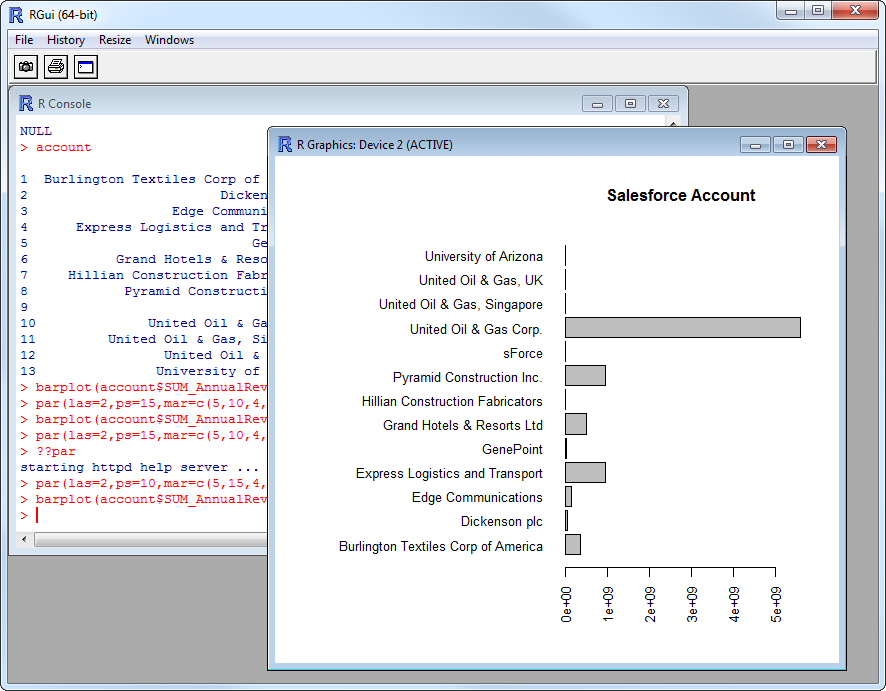Model Context Protocol (MCP) finally gives AI models a way to access the business data needed to make them really useful at work. CData MCP Servers have the depth and performance to make sure AI has access to all of the answers.
Try them now for free →Analyze QuickBooks Online Data in R
Use standard R functions and the development environment of your choice to analyze QuickBooks Online data with the CData JDBC Driver for QuickBooks Online.
Access QuickBooks Online data with pure R script and standard SQL on any machine where R and Java can be installed. You can use the CData JDBC Driver for QuickBooks Online and the RJDBC package to work with remote QuickBooks Online data in R. By using the CData Driver, you are leveraging a driver written for industry-proven standards to access your data in the popular, open-source R language. This article shows how to use the driver to execute SQL queries to QuickBooks Online and visualize QuickBooks Online data by calling standard R functions.
About QuickBooks Online Data Integration
CData provides the easiest way to access and integrate live data from QuickBooks Online. Customers use CData connectivity to:
- Realize high-performance data reads thanks to push-down query optimization for complex operations like filters and aggregations.
- Read, write, update, and delete QuickBooks Online data.
- Run reports, download attachments, and send or void invoices directly from code using SQL stored procedures.
- Connect securely using OAuth and modern cryptography, including TLS 1.2, SHA-256, and ECC.
Many users access live QuickBooks Online data from preferred analytics tools like Power BI and Excel, directly from databases with federated access, and use CData solutions to easily integrate QuickBooks Online data with automated workflows for business-to-business communications.
For more information on how customers are solving problems with CData's QuickBooks Online solutions, refer to our blog: https://www.cdata.com/blog/360-view-of-your-customers.
Getting Started
Install R
You can match the driver's performance gains from multi-threading and managed code by running the multithreaded Microsoft R Open or by running open R linked with the BLAS/LAPACK libraries. This article uses Microsoft R Open 3.2.3, which is preconfigured to install packages from the Jan. 1, 2016 snapshot of the CRAN repository. This snapshot ensures reproducibility.
Load the RJDBC Package
To use the driver, download the RJDBC package. After installing the RJDBC package, the following line loads the package:
library(RJDBC)
Connect to QuickBooks Online as a JDBC Data Source
You will need the following information to connect to QuickBooks Online as a JDBC data source:
- Driver Class: Set this to cdata.jdbc.quickbooksonline.QuickBooksOnlineDriver
- Classpath: Set this to the location of the driver JAR. By default this is the lib subfolder of the installation folder.
The DBI functions, such as dbConnect and dbSendQuery, provide a unified interface for writing data access code in R. Use the following line to initialize a DBI driver that can make JDBC requests to the CData JDBC Driver for QuickBooks Online:
driver <- JDBC(driverClass = "cdata.jdbc.quickbooksonline.QuickBooksOnlineDriver", classPath = "MyInstallationDir\lib\cdata.jdbc.quickbooksonline.jar", identifier.quote = "'")
You can now use DBI functions to connect to QuickBooks Online and execute SQL queries. Initialize the JDBC connection with the dbConnect function.
QuickBooks Online uses the OAuth authentication standard. OAuth requires the authenticating user to log in through the browser. To authenticate using OAuth, you can use the embedded OAuthClientId, OAuthClientSecret, and CallbackURL or you can obtain your own by registering an app with Intuit. Additionally, if you want to connect to sandbox data, set UseSandbox to true.
See the Getting Started chapter of the help documentation for a guide to using OAuth.
Built-in Connection String Designer
For assistance in constructing the JDBC URL, use the connection string designer built into the QuickBooks Online JDBC Driver. Either double-click the JAR file or execute the jar file from the command-line.
java -jar cdata.jdbc.quickbooksonline.jar
Fill in the connection properties and copy the connection string to the clipboard.

Below is a sample dbConnect call, including a typical JDBC connection string:
conn <- dbConnect(driver,"jdbc:quickbooksonline:InitiateOAuth=GETANDREFRESH")
Schema Discovery
The driver models QuickBooks Online APIs as relational tables, views, and stored procedures. Use the following line to retrieve the list of tables:
dbListTables(conn)
Execute SQL Queries
You can use the dbGetQuery function to execute any SQL query supported by the QuickBooks Online API:
customers <- dbGetQuery(conn,"SELECT DisplayName, Balance FROM Customers")
You can view the results in a data viewer window with the following command:
View(customers)
Plot QuickBooks Online Data
You can now analyze QuickBooks Online data with any of the data visualization packages available in the CRAN repository. You can create simple bar plots with the built-in bar plot function:
par(las=2,ps=10,mar=c(5,15,4,2))
barplot(customers$Balance, main="QuickBooks Online Customers", names.arg = customers$DisplayName, horiz=TRUE)


